Ledebouria davidsoniae
Ledebouria davidsoniae (U.Müll.-Doblies & D.Müll.-Doblies) J.C.Manning & Goldblatt
Family: Hyacinthaceae
Common names: striped African hyacinth
Introduction
Dwarf bulbous plant with small, striped leaves and pale pink to whitish flowers in spring and summer.
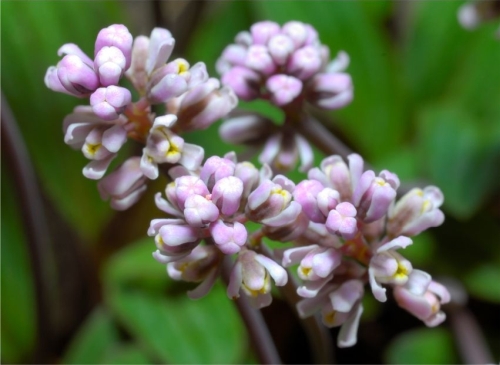
Description
Description
Dwarf, deciduous bulbous plants, 30–50 mm high, usually occurring as clusters of a few to numerous plants, in small groups. Each plant produces 2 to 5, broad, oblong to elliptic, erect to spreading leaves up to 30–50 mm long, including a pseudopetiolate (petiole-like) leaf base. The leaves are dark olive green, striped on the upper surface and deep red underneath, the petiole-like leaf base is also dark red.
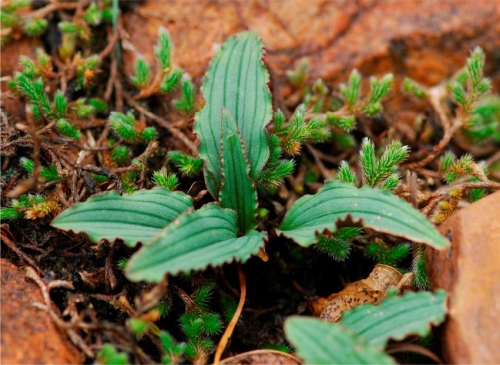
A slender, erect flower spike, up to 70 mm high, is produced in early spring and summer (August to November), usually in response to the summer rains. The flower spike bears 15 to 20, tiny, pale pinkish buds. The individual florets (small flowers) barely open when mature, and usually only the outer three tepals (petals) spread to expose the inner three tepals (petals), which remain connate (touching) and conceal the inner parts of the flower. After the flowers are pollinated, the green seed capsules develop quickly and split open within a few weeks to release the tiny, blackish glossy and wrinkled seeds.
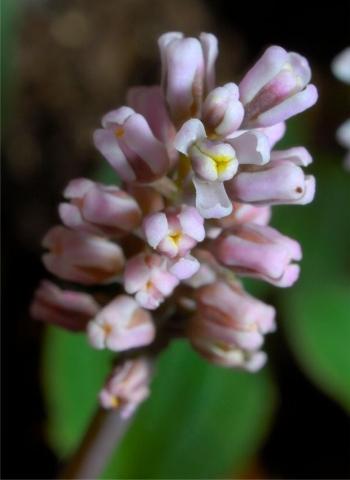
Conservation Status
Status
This species is listed as Vulnerable (VU D2) on the Red List of South African Plants and is considered threatened in its natural range by mining and development.
Distribution and habitat
Distribution description
The striped African hyacinth occurs in Mpumalanga province in the Blyde River Nature Reserve, it is known from three locations where it occurs in rock crevices in grassland and savannah vegetation types. This species is endemic to South Africa.
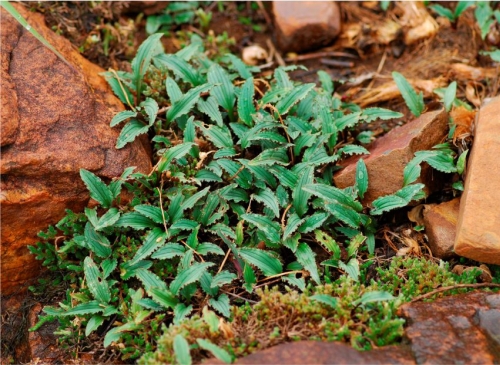
Derivation of name and historical aspects
History
This species was first collected in 1977 and only described in 1997, by the German husband and wife Botanist team Drs Ute & Dietrich Müller-Doblies. The species was originally described as Drimiopsis davidsoniae, however the genus Drimiopsis was combined into Ledebouria in 2004 by the South African botanist Dr John Manning, who also created two sections (2012) in Ledebouria to accommodate the closely allied groups (section Drimiopsis and section Resnova) that were formerly recognised as separate genera. The species is named after Lynette Davidson, who collected the original material with the Müller-Doblies, although no further information about this person is recorded by them in their description, it is likely that she discovered the species and then accompanied the Müller-Doblies to the location.
The genus Ledebouria is named in honour of the German-Estonian botanist, Professor Carl Friedrich von Ledebour (1785–1851). South Africa has 61 species of Ledebouria, with several more species occurring across southern, western, eastern and northeast Africa and into India. The genus Ledebouria is a member of the Hyacinth Family and is well represented especially across eastern summer rainfall parts of South Africa. L. davidsoniae is most closely related to L. pusilla from which it differs by the pinkish white flowers and the striped leaves.
This species possesses typical Drimiopsis-type flowers in which the outer tepals (petals) only open slightly and do not become reflexed, while the inner tepals remain closed even when the flowers are mature. This distinction can be used to distinguish the section Drimiopsis from the other two sections Ledebouria and Resnova.

Ecology
Ecology
As is the case with most ledebourias, there is no documented information on the specific ecology of L. davidsoniae. Porcupines are known to dig out and eat the bulbs of several species of Ledebouria and large ungulates have been observed to browse the leaves. Observations have been made of various pollinators including small solitary bees, honey bees as well as small flies and wasps visiting the flowers when they are open. The visiting pollinators need to physically open the inner three tepals (petals) in order to gain access to the center of the flower where the pollen and nectar is located. The flowers are strongly hyacinth-scented, especially in the warmer parts of the day. The seed is black and roundish with a wrinkled glossy seed coat.
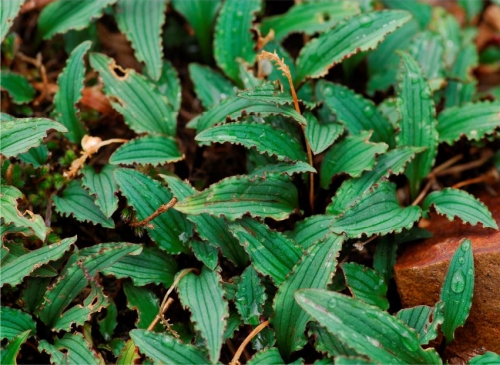
Uses
Use
There are no known or recorded uses specifically of the striped African hyacinth. The genus Ledebouria generally has been cited as having been used medicinally for various purposes including pregnancy, diarrhoea, influenza, backache, skin irritations, wound treatment as well as lumbago. The genus is also reported as being poisonous, although it is also reported that Bushmen ate the bulbs of certain species, including L. revoluta and L. apertiflora. However, these may have been cooked or prepared in some manner to destroy the toxins, which is not specifically documented. Despite the fact that porcupines and some large ungulates have been recorded as eating the bulbs and leaves respectively, the entire genus should be regarded as being poisonous as a precaution.
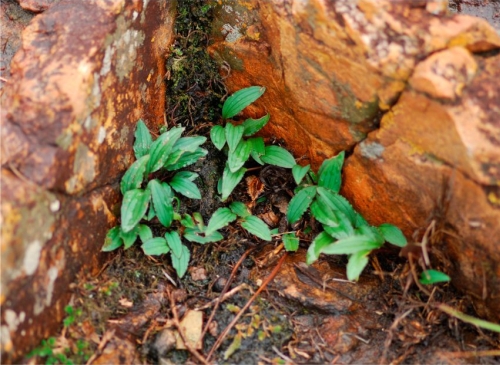
Growing Ledebouria davidsoniae
Grow
The striped African hyacinth is easily cultivated, but due to their small size, they are best maintained in containers. Bulbs should be grown outdoors, in terracotta pots, in full sun to semi-shade, in a warm, summer-rainfall climate.
Plant the bulbs in humus-rich loam soil or a well-drained potting medium rich in organic material, with some sifted well-aged kraal (cattle) manure or mature compost added. Watering should be limited to the warm summer growing season. Pots should be allowed to be completely dry out during the winter rest period. Plants can withstand cold temperatures in winter, providing the soil is kept completely dry and the bulbs are dormant.
The pots should be moved out of the rain during the dormant winter season, and kept in a dry position with good air movement. Summer growth is initiated in spring (September to October) by the onset of warmer temperatures or light rain. Emergence of the flowers often precedes the leaves in this species, however, under moister conditions the flowers may emerge simultaneously with the leaves. Watering can commence as soon as the flowers or leaves break through the soil surface.
In cultivation, adult plants can become afflicted with scale insect and mealy bug (including on the roots) especially if the cultural conditions are not ideal. Both of these maladies can be managed with contact or systemic insecticides. Ants will often bring and spread such infestations and as such it is best to manage ant populations in the area where the plants are grown.
Ledebouria davidsoniae is easily propagated from fresh seed (seed cannot be stored for longer than 1 year). Seed should be sown in spring or summer. Sow seed in pots or trays, on a finely sifted surface of the same growing medium. Cover with a fine layer of approx. 2–3 mm of the sifted medium. Water weekly and keep in a warm and protected position out of direct sunlight. Seeds usually germinate within 2–3 weeks, after which watering should be reduced depending on rainfall. Bulblets can be allowed to remain in their natal container for the first year, after which they can be planted out into individual or community pots. Flowering can begin at 2 to3 years from seed.
References
- Hankey, A.J. 2019. Proposed English common names for African hyacinths (genus Ledebouria). Plantlife SA, Vol 47:7 https://plantlifesouthafrica.blogspot.com/
- Lötter, M., Burrows, J.E., McMurtry, D., Burns, S. & von Staden, L. 2006. Ledebouria davidsoniae (U.Müll.-Doblies & D.Müll.-Doblies) J.C.Manning & Goldblatt. National Assessment: Red List of South African Plants version 2020.1. Accessed on 2022/07/07
- Müller-Doblies, U. & Müller-Doblies, D. 1997. A partial revision of the tribe Massonieae (Hyacinthaceae). Feddes Repertorium 108 (1–-2): 49–96.
- Manning, J.C., Goldblatt, P. & Fay, M.F. 2004. A revised generic synopsis of Hyacinthaceae in sub-Saharan Africa, based on molecular evidence, including new combinations and the new tribe Pseudoprospereae. Edinburgh Journal of Botany 60: 533–568.
- Wikipedia. Carl Friedrich von Ledebour. http://en.wikipedia.org/wiki/Carl_Friedrich_von_Ledebour. Accessed 6 November 2018.
Credits
Andrew Hankey
Walter Sisulu National Botanical Garden
November 2022
Plant Attributes:
Plant Type: Bulb
SA Distribution: Mpumalanga
Soil type: Loam
Flowering season: Spring, Early Summer
PH: Neutral
Flower colour: White, Pink, Mauve/Lilac
Aspect: Full Sun, Morning Sun (Semi Shade)
Gardening skill: Easy
Special Features:
Horticultural zones










Rate this article
Article well written and informative
Rate this plant
Is this an interesting plant?
Login to add your Comment
Back to topNot registered yet? Click here to register.